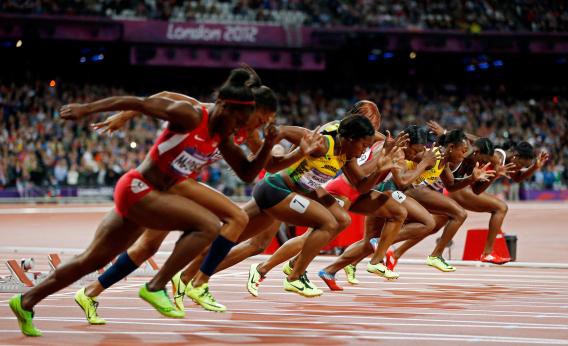Got to hurry, got to hurry, I don’t believe you worry
Motorhead
Take it back, take it back, You know you can’t do that
Don’t want no sleep, Just hide and seek
Yes, I’m a speedfreak, Baby, I’m a speedfreak
As sprinters we want to be able to move our feet as fast as possible. Regardless if we are clicked into pedals on a bike, wearing spikes running down a track or on the field in a team sport we do want to get our speed of movement as high as possible for our activity. But we are not thrown out of an airplane, finding ourselves moving as fast as we possible can with no effort. We need to get up to speed all by ourselves, by accelerating our body.
With every step or every revolution of the pedal, if our power is higher than the braking forces acting upon us our speed of movement increases, until at some point the net forward momentum equal to those braking forces and we are now moving at maximum velocity.
In track and field events extending the acceleration phase is something positive and largely correlated with lower sprinting times and better chance of winning. This comes from the fact that if you can push your acceleration phase from 25m (normal for a beginner) to 70m (world record 100m runner) then your speed at the end of that acceleration is higher, but also, since that maximum speed cannot be maintained for a very long time, that the deceleration phase of the race will be shorter. Even a short race like the 100 meters is damn long if there is 70m to go when you’re entering the “die a glorious death”-phase (or, if you’re unlucky, just the “die a death”-phase).
Actually, when it has been modeled, a longer acceleration phase always wins over a shorter one and thus the objective for a 100m sprinter should always be to increase the maximal speed, as this will also emphasize to keep accelerating. For as long as the race is if that was possible.
For the team sport athlete, or the cyclist, there are however other things to consider. The dream scenario of the straight sprint down the full fields in football or rugby, is never more than just a dream as the opponents are eager to crush you with a tackle. This makes the rate of acceleration even more important as you want to be able to get up to speed and past that defender in the little time and distance available.
One would think situation for the cyclist would be similar to the 100m runner, but there are several differences that motivates him or her, similarly to the field sport athlete, to increase the rate of acceleration rather than to extend the distance of it.
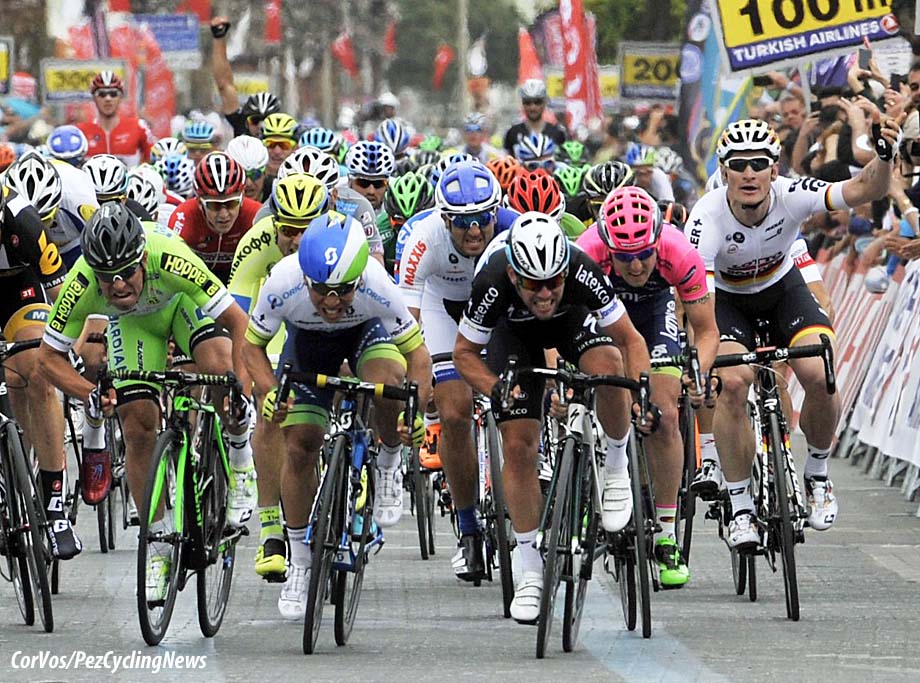
While the braking force of air resistance for the runner is not something that he or she can affect much – it is what it is – this is not true for the cyclist but something that can be changed to a large degree by assuming more aerodynamic posture on the bike. While the biomechanical characteristics of the standing position offers the higher power outputs suitable for creating the high forces needed to accelerate, the seated position offers kinematic, energy cost and mechanical efficiency.
Aerodynamic drag is by far the most significant variable for cycling, increasing by the square of our speed until accounting for 90% of total resistance over 50kph. The cyclist will at some point be able to increase his speed more by sitting down forming a smaller frontal area rather to try to extend the standing acceleration phase. Because of this the cyclist benefit from accelerating quickly in order to reap the advantages available by “going low” earlier than his opponents, spending less energy while preserving his or her speed.
If we consider track cycling there are even more constraints, as we also will not be able to keep standing up when going fast. The speed will increase the G-forces in the curves which will eventually push us down into the saddle. This makes most track cyclists stand up only until riding into the second curve (turn 3 or 4 if you talk “track geography”), giving them a distance to accelerate of something between 150 and 200m, depending on how strong and fast they are and what gearing they ride.
Speed, it seems to me, provides the one genuinely modern pleasure.
Aldous Huxley
So there is a difference between how to approach complementary training of maximal speed in track and field versus in field sports and cycle sprinting. In the former you could anchor the training prescription from the speed side, as it should also carry over to the improved acceleration necessary to reach higher speed, but in the latter ones we probably should address the training from more of an emphasis on acceleration. Limited by time or distance we likely should seek to improve the rate of acceleration, always get stronger and more powerful.
While there is a lot to gain at high stride or pedaling frequencies from increased tendon stiffness, when it comes to increase the rate of acceleration at lower velocities we would likely need to produce more muscular force down into the pedals or ground, something ordinarily categorized as increased strength.
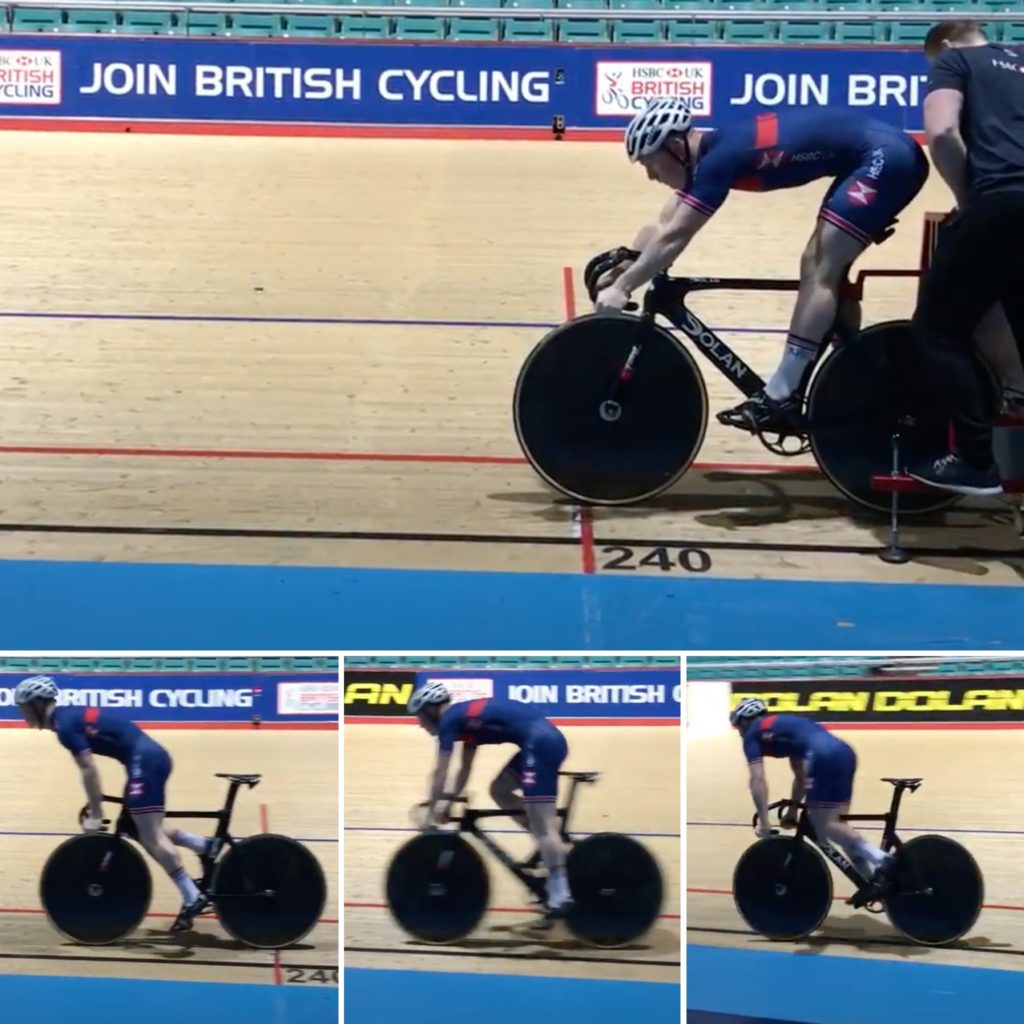
Similar to the acceleration phase in track and field there is an change in the relative contribution of horizontal (forward motion of the hip) and vertical application of force in cycling. In the track and field this relative horizontal movement is largest when exiting the starting blocks until at maximal velocity almost all force is directed straight down into the ground. When out of the saddle in cycling, as speed and cadence is increased, horizontal movement of the hip also is reduced until it is more or less locked over the saddle. So when selecting exercises to provide overload to support the acceleration phase it seems reasonable to have some orientation of the force forward.
During a sprint the max power is reached within the very first seconds of the effort, but does not last long because the optimal loading conditions for power are changed with the increase of speed. With so little stimulus at this optimal velocity for power per interval of training it makes for many hard efforts to provide enough “hits at the system” to force adaptation.
Like I highlighted when describing a process for selecting complementary exercises for the start in my last article, we should seek to find exercises that provide some similarity of sensory patterns and intention. This should enhance the possibility of transferring the strength from the gym to the field of the sport. This though process should make us give prominence to exercises that has a somewhat similar finishing position as in the sport. It would also be a bonus if the starting position is distinct and if there is some actual movement of the body in the direction that the sport.

Pedal force is ultimately produced by the muscles that span the hip, knee and ankle joints. The main function of the hip extensors and knee extensors is to generate force that is to be transferred to the pedal. It has been shown that exercises where the muscle is shortening (concentric) and exercises where the muscle is lengthening (eccentric) both are able to increase the muscles ability to forcefully open these joints.
However, as discussed in the previous article, there are some possible downside with pre-loading with a counter-movement or a slow eccentric action as it might impair the body ability to use co-contractions. Co-contractions are the only efficient option available “on the field” to reduce the muscle-slack that has to be taken care of before being able to produce movement, and this ability should be safeguarded.
The calf muscles have two functions: in addition to producing pedal force themselves they must also stiffen the ankle so that the force developed by the knee and the hip can be effectively transferred to the pedal. If your ankle-foot system is not able to transmit that force, “deforming” under tension, this impairs your technique and by extension radically impairs your performance. This stiffening of the ankle also has to happen really quickly in order for as little as possible of such leakage of force to occur.
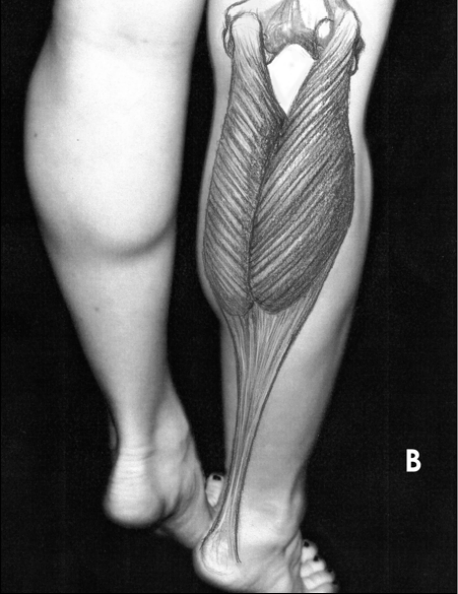
The maximum force developed by a muscle is proportional to the number of sarcomeres, the basic contractile unit of muscle fiber, in parallel while the maximum shortening velocity is proportional to the number of sarcomeres in series.
With their pennate structure, allowing for more sarcomeres in parallel, the calf muscles are perfect for very brief efforts of very high force production. In order to support this they are also designed for a “pumping” or recurring function such as in running and cycling. In longer duration actions the blood circulation needed for this is impaired, as exposed by the sensation of pain (“the pump”) that accompanies such exercises (for example the calf raise).
Because of it’s muscle fiber orientation the calf muscles are not really suited for generating a large range of motion, and when they are used in sports remains more or less the same range (isometric). This optimum length of tension in muscle can be shifted to longer muscle lengths, especially by large range of motion eccentric exercise, but altering this length-tension relationship in a muscle could also alter it’s function and might be something to avoid for muscles of this type.
Let’s reiterate.
When selecting complementary exercises for the acceleration phase (out of the saddle) of cycle sprinting we would like to find exercises that
- Extend the time at high power production, at what we can call “optimal velocity”, in order to get “stronger” and be able to accelerate faster.
- Limit the possible pre-stretch or slow eccentric action that could affect the co-contraction ability that is necessary for the muscles to be efficient at going from slack to tense.
- Work the muscles around the hip and knee joints mainly through shortening (concentric action) while at the same time work the calf and ankles mainly at constant length (isometric action).
- Provide muscular overload and if possible, provide sensory similarity in body positioning and movement.
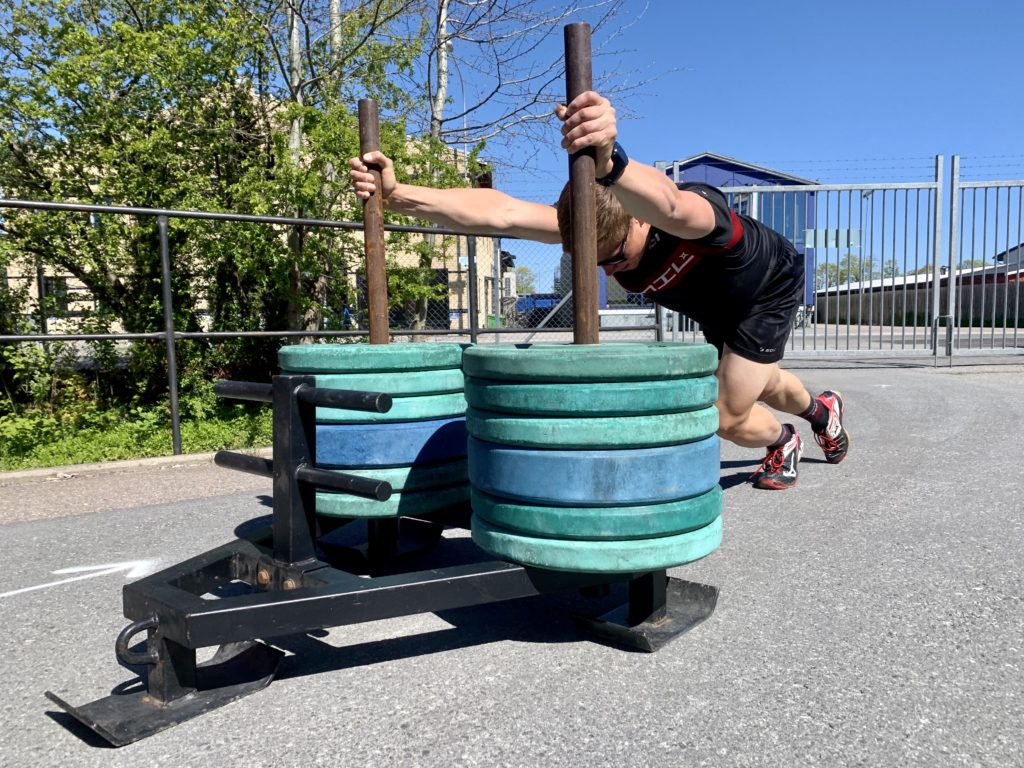
Sprinting on a slight incline is a good way of adding resistance and by doing that also maintain the athlete at conditions around maximum power. However doing this in the gym, where higher overload than in the specific conditions that is to be found on the bike could and should be sought, is more complicated. One could try to use a air and magnet resisted devices like the Wattbike, but while providing both a resistance increasing both exponentially and linearly with speed, it fails to provide the high force demands found in the inertia of the initial acceleration. While coming close, it just does not feel the same at those first few seconds.
When adding load to a sled and pushing or pulling it, we also, in addition to the increased resistance of the mass being accelerated (bodyweight plus sled) have to fight friction. While this coefficient of resistance will vary with different sleds (new, old, rusty?) and different surfaces (dry asphalt, wet turf?) it will always provide resistance to prolong conditions similar to the “optimal velocity” in the beginning of the acceleration, and provide more “stimuli per set” than unloaded acceleration.
The overload generated by heavy sleds should add to lower limb strength, and possibly also help to transfer strength from other less contextual strength movements like the squat into cycling (or running). This overload is placed upon all the joints simultaneously, including the often forgotten ankle joint. The sled push is also working the hip and knee joints with concentric action, while the ankle joint works isometrically, supporting their respective functions in forward acceleration.
While the definite answer to if one should load the sleds heavy or light is not yet established, there are vast amount of data suggesting to go heavy rather than not. The eminent French scientist JB Morin notes that without heavy loads, mechanical exposure to very acute angles is not possible compared to when using light loads.
Considering that we established that the sprint cyclist would rather seem to prefer increased muscular strength over tendon stiffness in order to increase the rate of acceleration, and if we accept that more overload likely shifts the adaptation in this direction then it seems reasonable to go for heavy loads.
I would make three arguments for deciding to push the sled, rather to pull it forward. First, the pushing style seem to make athletes to be able to work with heavier weights, which might be able to shift the adaptation to our muscular preference. Second, pushing with the arms does appear to further increase forward lean and alter foot placement, which may favor increased horizontal impulse. Third and possibly most important, having tension throughout the whole body, from the hands to the feet pushing into the ground is more contextual than having the hands free. The longer chain of activation is, even though in cycling we pull ourselves down rather than push our way forward, likely to be more similar in intermuscular demands of transferring force through joints all the way down to the feet.
How heavy is heavy? Well, rather than trying to find the optimal individual load it has been shown that to use a percentage of body weight correlates well between individual load and performance. In studies the groups using “very heavy” loads has been using ~80% of their body weight on the sled, but since this has been pulled rather than pushed I would not hesitate to go heavier.
In our never ending pursuit to ride bigger gears, maybe we should also strive to always push heavier sleds?

- “Cycling Science”, https://books.google.se/books?id=zPR6DwAAQBAJ
- “Aero Tech #3 – Sprint Aero Position”, https://www.velobike.co.nz/blog/2019/6/23/aero-tech-in-track-3-aero-positions
- “A household name in under 34 seconds”, https://www.cyclingnews.com/features/a-household-name-in-under-34-seconds-1/
- “Digging into Elite Sprint Kinetics and Training with JB Morin”, https://simplifaster.com/articles/digging-elite-sprint-kinetics-training-jb-morin/
- “Why are ankles important to cycling”, https://www.uksca.org.uk/uksca-iq/article/plyometrics/1917/the-effect-of-isometric-and-plyometric-exercise-on-musculotendinous-ankle-stiffness-and-its-subsequent-effect-on-performance-in-elite-sprint-track-cycling
- “Altering the Length-Tension Relationship with Eccentric Exercise”, https://www.researchgate.net/publication/6117297_Altering_the_Length-Tension_Relationship_with_Eccentric_Exercise
- “Sled pushing and pulling to enhance speed capability”, https://www.researchgate.net/publication/331054535_Sled_pushing_and_pulling_to_enhance_speed_capability
